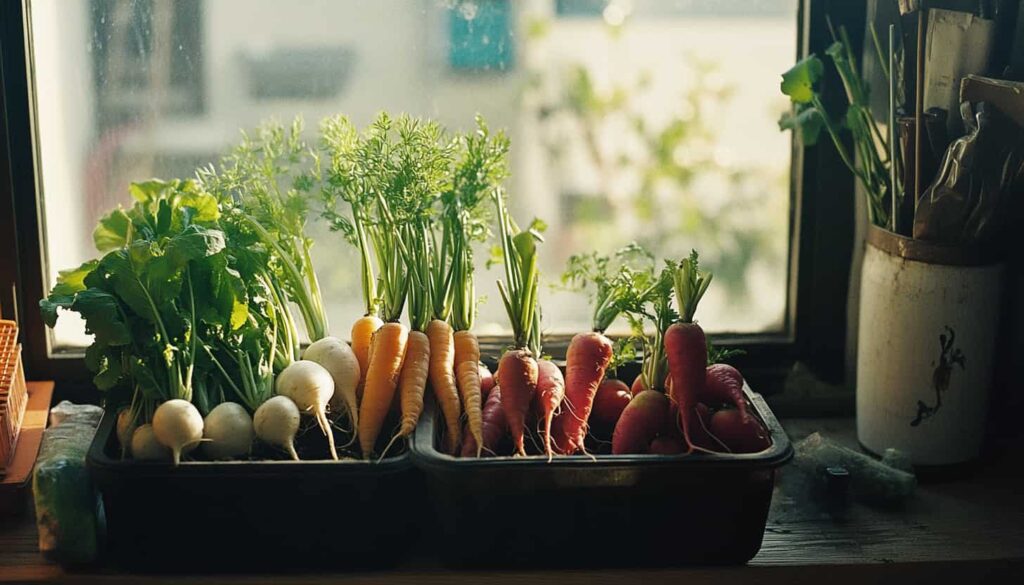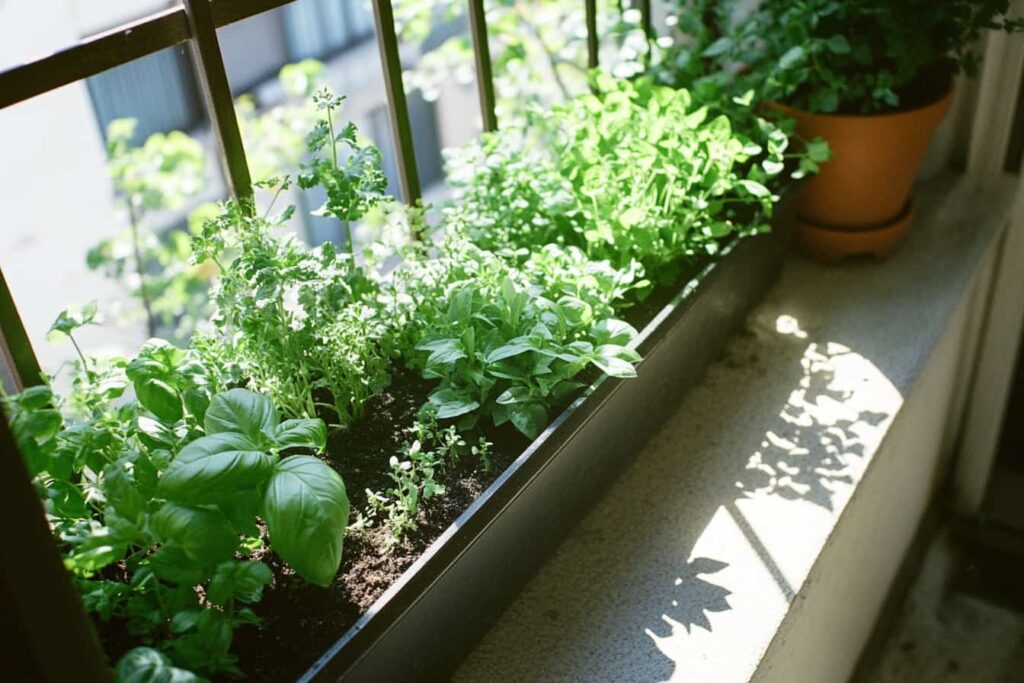Winter can sometimes feel like the end of the gardening season, but with indoor winter gardening, that doesn’t have to be the case. The truth is, you can still grow fresh, healthy vegetables indoors even while the world outside is covered in snow. Imagine the joy of harvesting your own basil or kale for a cozy winter meal, right from the comfort of your home. In this guide, I’ll share everything you need to know about indoor winter gardening and how to create a productive indoor garden that thrives during the cold months.
Setting Up for Success
a) Introduction to Indoor Winter Gardening
Ever considered the benefits of cultivating vegetables indoors throughout the winter? Let me tell you, it’s about more than just having fresh produce. There’s something magical about nurturing a living plant while it’s cold outside. The warmth inside, combined with the vibrant green of your indoor veggies, can add an amazing boost to your mood and well-being. Moreover, it’s commonly acknowledged that eating fresh foods in the winter is important.
b) Preparing Your Indoor Space

Before we get to planting, let’s talk about how to create the perfect environment. Growing veggies indoors in winter can be quite different from your typical outdoor garden, but with a little preparation, you’ll be amazed at how well your plants do!
- Lighting: Choose a well-lit spot, preferably near a window with south-facing light. If natural light is scarce, using grow lights is the ideal solution. (Trust me, you don’t want leggy plants that reach desperately for light.)
- Temperature and Humidity: Vegetables prefer moderate warmth, so avoid drafts and chilly windowsills. Keep the room temperature within the range of 65 to 75 °F.
- Essential Tools: You’ll need containers with good drainage, quality soil, and basic tools like a small trowel, spray bottle for misting, and maybe even a pair of cute gardening gloves—because, why not?
If you’re serious about making your indoor garden a success, Epic Gardening’s guide to indoor vegetable gardening is a fantastic resource that covers everything from lighting to soil.
Top Vegetables to Grow Indoors in Winter
I know you’re excited to get started, so let’s dive into which veggies you can grow indoors and thrive through the winter months. These are my top picks, which are not only simple to grow but also provide numerous health benefits.
a) Leafy Greens

Leafy greens are an ideal option and one of the simplest vegetables to cultivate indoors. Rich in nutrients, they make a valuable addition to your winter diet.
- Lettuce: Choose varieties like Romaine or Butterhead. They have a rapid growth rate and can be harvested multiple times!
- Spinach: Love spinach in your morning smoothie or omelette? It’s super easy to grow, even in smaller spaces.
- Kale: Who doesn’t love kale chips? Kale is hearty, grows quickly indoors, and can tolerate cooler temps.
Just imagine how satisfying it will be to snip some fresh spinach for your salad in the middle of winter! I can’t tell you how much I’ve enjoyed the taste of home-grown greens while it’s frosty outside.
b) Root Vegetables

Root vegetables may seem tricky to grow indoors, but they’re not! All they require is a sufficiently deep container and quality soil. And let’s be honest, growing your own carrots inside feels like a superpower.
- Carrots: Grow them in deep pots and make sure they have plenty of light. Choose shorter varieties like Thumbelina or Nantes.
- Radishes: These spicy little vegetables mature quickly and don’t require a ton of space, making them perfect for indoor growing.
- Beets: Beets are another great choice. They need a bit more room, but their colorful greens are edible too!
Were you aware that radishes can be ready for harvest in just 30 days from planting the seed ? That’s like planting a little miracle right in your living room!
c) Herbs

Herbs are a must-have for indoor winter gardening. Not only are they simple to cultivate, but they also imbue your home with a delightful scent.
- Basil: Cultivate this aromatic herb on a bright windowsill. It’s perfect for adding to your favorite Italian dishes.
- Mint: Mint grows like wildfire, so make sure to keep it contained unless you want a mint takeover!
- Parsley: It’s not just for garnish—parsley is packed with vitamins and grows well indoors.
I love keeping a pot of basil on my kitchen counter. There’s something wonderful about plucking fresh basil leaves while making pasta or homemade pizza.
d) Fruiting Vegetables

If you’ve got a bit more space and time, fruiting vegetables are a fun and rewarding challenge.
- Peppers: Small varieties of peppers, like chili or bell peppers, can do surprisingly well indoors with the right care.
- Cherry Tomatoes: While tomatoes typically need a lot of light, cherry tomatoes can thrive indoors with a bit of extra love and some good grow lights.
If you’re looking for some inspiration on growing fruiting vegetables indoors, check out Gardening Channel’s guide to cold-weather vegetables. It’s filled with helpful tips for achieving the best results!
e) Legumes

Legumes might not be the first thing you think of for indoor gardening, but they can be grown inside with great results.
- Peas: Peas need support, so plant them in pots with small stakes or trellises.
- Beans: Bush beans are your best bet indoors. They take up little space and grow relatively fast.
Picture this: you’re harvesting your very own home-grown peas in the middle of January. Sounds pretty amazing, right?
Key Considerations for Successful Indoor Winter Gardening
a) Choosing the Right Containers

Although it may not appear important, selecting the right containers is a crucial aspect of indoor gardening. Without good drainage, your plants will struggle, and that’s the last thing we want!
- Make sure each container has drainage holes.
- Choose pots deep enough for root vegetables and wide enough for herbs and greens.
b) Watering Tips for Indoor Plants

It’s important to prevent overwatering, a frequent problem in indoor gardening
- Water the plant once the top inch of the soil feels dry
- For leafy greens, misting can help maintain the right humidity without drowning the roots.
c) Soil and Fertilization

Indoor plants often need a bit of extra love when it comes to nutrients. Opt for a premium potting mix and think about utilizing organic fertilizers.
d) Dealing with Indoor Pests

Pests can still reach your plants, even when they are grown indoors.
- Aphids and spider mites: Spray your plants with a solution of water and mild soap.
- Fungus gnats: Keep the soil surface dry and use sticky traps to catch any pests.
Frequently Asked Questions (FAQs)
Let’s answer some of the most common questions about indoor winter gardening.
- Which vegetables are simplest to cultivate indoors during winter? Lettuce, spinach, and kale are superb options among leafy vegetables.
- What amount of light is required for indoor vegetables during winter? Ideally, they need 6-8 hours of light. If natural light is scarce, investing in grow lights is advisable.
- Is it possible to cultivate vegetables indoors without using grow lights? Yes, provided you have a windowsill that receives ample sunlight.
- What is the time frame for growing vegetables indoors? It varies. Radishes can be ready in 30 days, while carrots and tomatoes may take a couple of months.
- What is the best indoor temperature for growing winter vegetables? Most vegetables thrive at 65-75 °F.
Final Considerations : Inviting the Outdoors Inside
You don’t have to let winter halt your enjoyment of gardening pleasures. In fact, indoor gardening can become one of your favorite winter activities! Whether you start small with herbs on your windowsill or go all out with leafy greens, root veggies, and even tomatoes, the possibilities are endless.
If there’s one thing I’ve learned from indoor gardening, it’s this: growing your own food feels incredible. And when you bite into a crisp radish or snip fresh parsley on a cold winter day, you’ll understand why so many people are turning their homes into tiny winter gardens.
So, why wait? Let’s start planting!







